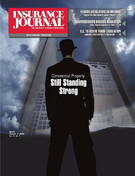Floridians will long remember 2004 as the year of the hurricane. The Atlantic region had 15 named storms, nine of them hurricanes. Of those, four hit Florida in the span of six weeks.
Recently, hurricane forecaster William Gray, of Colorado State University, predicted that 2005 would be another active year for hurricanes. While no one expects a similarly calamitous string of storms in 2005, no one really expected it in 2004, either.
The 2004 season stretched the resources of many organizations as they responded to multiple catastrophes simultaneously. The Red Cross opened nearly 2,000 shelters and evacuation centers, provided shelter to almost 500,000 evacuees, and served more than 11 million meals.
Utility crews were in short supply with 3.4 million people losing power as a result of Hurricane Frances and 2.8 million due to Charlie.
There were also too few roofers and contractors to handle construction projects in the wake of the storms and building supplies were in short supply. Construction projects experienced long delays, prices skyrocketed, and consumers (including insurers) complained of price gouging.
For insurers it was all hands on deck, as companies brought in claims adjusters and hired workers from around the country to process millions of claims.
Yet, in the face of all these challenges, the insurance industry responded admirably, partly due to lessons learned from 1992’s Hurricane Andrew.
Andrew devastated the insurance marketplace. Insurers, regulators and legislators recognized the need to fundamentally reassess the risk associated with writing property insurance in the state. After much deliberation, they agreed on reforms that energized the private insurance market to make insurance available and affordable. The Legislature instituted many reforms including the creation of the Florida Hurricane Catastrophe (Cat) Fund and the establishment of windstorm deductibles based on the property’s insured value.
The fundamental reforms adopted by the Legislature after Andrew withstood an unprecedented test. However, many serious problems were also discovered. The reforms following Andrew were designed to address one major hurricane. Now we know we must make adjustments to account for a wider range of circumstances, including multiple major storms during one season, and the potential for hurricane-related losses in central Florida.
With the enactment of legislation during Florida’s recent Special Session to reimburse consumers for multiple hurricane deductibles, the attention of lawmakers is quickly shifting to the possibility of another special session this month and the Legislature’s regular session in March.
To ensure that the insurance industry is prepared to rebuild Florida after the next hurricane season, insurers are working with policymakers to find solutions that will improve the current system for handling catastrophic losses while enhancing the state’s insurance market.
One effort that the Property Casualty Insurers Association of America undertook with the Florida Department of Financial Services is the creation of an adjuster matching database system that will help to speed up claims processing. The system will help expedite the claims process by putting adjusters where they’re needed. Adjusters will be able to enter current contact information and the number of available adjusters by county. Insurers can then log in and review the list of available adjusters by either county or company and contact them as needed. This will be especially useful when next year’s hurricane season rolls around.
It is critically important for insurers to be able to quickly rebuild their reserves for future storms. Following Andrew, the (then) Florida Department of Insurance approved rates that more appropriately re¾ected the risk of loss. Andrew demonstrated the magnitude of the potential for loss and this season’s $20 billion in losses reaffirms the point. Without charging adequate rates over the past 10 years, insurers would never have been able to meet their promise to pay claims for consumers. However, even with rate increases, insurers have depleted their reserves and many major insurers were forced to get cash infusions from their parent companies outside the state.
As we look to upcoming legislative sessions, public policymakers face important decisions regarding the future of the state’s insurance marketplace. PCI will work with policymakers on issues such as reviewing the Florida Building Code, overhauling the residual property market, finding the proper retention level for the Cat Fund, enacting tort reform, and creating a healthy and competitive property insurance marketplace that will make insurance more affordable and available in Florida.
William Stander is PCI Regional Manager. PCI iscomposed of more than 1,000 member companies, representing the broadest cross-section of insurers of any national trade association. He can be reached at William.stander@pci.net. Without charging adequate rates over the past 10 years, insurers would never have been able to meet their promise to pay claims for consumers.
Topics Florida Catastrophe Mergers & Acquisitions Natural Disasters Carriers Claims Hurricane Property Market
Was this article valuable?
Here are more articles you may enjoy.


 Zurich to Buy AIG’s Travel Insurance Business for $600 Million
Zurich to Buy AIG’s Travel Insurance Business for $600 Million  Guidance and Insurance Implications for the CDK Global Cyberattack
Guidance and Insurance Implications for the CDK Global Cyberattack  House Collapses Into Flood-Swollen River Near Minnesota Dam Amid Storms
House Collapses Into Flood-Swollen River Near Minnesota Dam Amid Storms  Allstate, Nationwide Post Dramatic Q12024 Homeowners Loss Ratio Drops: S&P
Allstate, Nationwide Post Dramatic Q12024 Homeowners Loss Ratio Drops: S&P 


